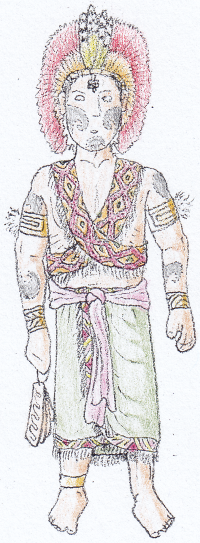Þonnani
Afnat: Akn-Þonnan
The þonnani1 are among the most powerful tribes inhabiting Þonnanó in southwestern Emlas, specifically So-najó-fnetap in the northeastern part. Their kingdom is centered around the city of Údranajó upon the central Ajok River, and is an important part of the land trade-route connecting Sanx to the west with Imkala and Dalra to the east, with all sorts of exotic goods flowing through the city every day.
As a result, þonnani culture has adopted a variety of different customs and adapted to their own native traditions, though imkalan influence has long been the most prominent in terms of dress, religion and architecture.
Colourful clothing is preferred, with dark red, pink, orange, yellow and olive green being most common.
Tattoos or red and black face- and bodypaint are popular and often serve as apotrophaic devices.
All kinds of tea is consumed, along with palm- or palm-sugar wine imported from the Vósali to the south.
While small, wooden shrines housing images of lesser divinities are found throughout the kingdom, the most powerful deities have larger temples dedicated to them, either carved from the living rock as imkalans do or, more recently, constructed out of stone and brick, sometimes encircling or even enclosing the former.
Human sacrifice is practiced by the þonnani to some extend, where select war captives are brought to a temple and offered to the gods, which is believed to transfer their qualities to þonanni warriors and as such, only the bravest and strongest captives are sacrificed.
The þonnani1 are among the most powerful tribes inhabiting Þonnanó in southwestern Emlas, specifically So-najó-fnetap in the northeastern part. Their kingdom is centered around the city of Údranajó upon the central Ajok River, and is an important part of the land trade-route connecting Sanx to the west with Imkala and Dalra to the east, with all sorts of exotic goods flowing through the city every day.
As a result, þonnani culture has adopted a variety of different customs and adapted to their own native traditions, though imkalan influence has long been the most prominent in terms of dress, religion and architecture.
Culture
Apparel
Þonnani clothing resembles that of the Imkalans for the most part, with men usually wearing little more than a loincloth of some sort and women a skirt and cover their chest via short cloak or a strip of cloth. Men of higher rank also wear a feather headdress and two diagonal sashes on their upper body, the latter which display patterns unique to each noble family, but otherwise the clothes worn by þonnani from all walks of life are roughly the same, only really varying in the quality of the materials used.Colourful clothing is preferred, with dark red, pink, orange, yellow and olive green being most common.
Tattoos or red and black face- and bodypaint are popular and often serve as apotrophaic devices.
Art
Architecture
Wood is the most common material used in þonnani architecture, only the royal palace and temples are made using bricks or stone, but even those buildings often imitate wooden ones as much as possible. Homes are either built on stilts or stone foundations in case of flooding, with livestock usually kept under the house. As with clothing, the houses are generally similar in construction regardless of the owners' status, but those of the upper classes use better quality materials, have more rooms (divided using woven palm-fiber screens) and are often adorned with carvings and gold.Cuisine
Þonnani diet consists mostly of cassava and other tubers, various vegetables, fruits and spices, fish, pork and wild game, along with arrowroot and waterlilies. Although the latter are eaten by the aristocracy to some extend, these crops are mostly intended for merchants and other travelers to feel more at home within þonnani territory; the waterlilies are prepared more or less they would be in Imkala, while the arrowroots are often made into noodles served in fish sauce for Sanxeans or Paróbaxi.All kinds of tea is consumed, along with palm- or palm-sugar wine imported from the Vósali to the south.
Language
While the þonnani speak various dialects of their own language amongst themselves, the most common tongue within the kingdom is a spoken and written trade language known as afnat, which is used to ease communication between the þonnani and other tribes inhabiting the region, and has become widely adopted by the vósali and Hefmólans as well. Afnat is written using an abugida, with slight variations in use outside the þonnani realm. Most official records and mythological tales are made using palm-leaf manuscripts or -less commonly- wooden boards, while monumental inscriptions and declarations are carved in stone.Religion
The þonnani worship a mixed pantheon of native deities and spirits along with ones adapted from imkalan mythology. Direct worship of greater deities via hymns, libations and the use of certain hallucinogens is generally restricted to royalty and select noble families, while commoners venerate totemic animals (particularly toucans and crocodiles), ancestral, tutelary and nature spirits by giving prayers and offerings of food, either at home or out in the fields, groves and by riverbanks.While small, wooden shrines housing images of lesser divinities are found throughout the kingdom, the most powerful deities have larger temples dedicated to them, either carved from the living rock as imkalans do or, more recently, constructed out of stone and brick, sometimes encircling or even enclosing the former.
Human sacrifice is practiced by the þonnani to some extend, where select war captives are brought to a temple and offered to the gods, which is believed to transfer their qualities to þonanni warriors and as such, only the bravest and strongest captives are sacrificed.
1Original icelandic: Þonnanir, singular: Þonnanir.





Comments